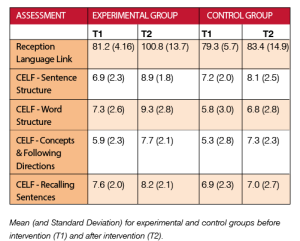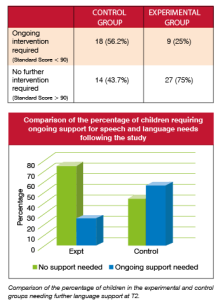Conclusions
The Language Link interventions enabled children to make more progress with their language skills across the year, than children in the control schools.
There were highly significant differences in performance for the experimental group at T1 and T2 compared to the control group, with more progress made across all the standardised assessment measures.
Infant Language Link is an effective wave 1 level SLCN package to help schools close the attainment gap.
Background
Language Link is an assessment and intervention package used by schools throughout the UK to boost language skills as a wave 1 intervention. To assess the impact of Infant Language Link we compared the progress of children from schools supported by the package with those from control schools supported by typical in-school SLCN support.
The study took place in 13 schools across Birmingham and Thurrock (Essex) with wide and varied catchment areas. The schools were allocated to two groups depending on their familiarity with the Language Link interventions. The 6 experimental schools were recruited through the Language Link website. They had all used the package previously for at least 1 year. The 7 control schools were identified either by the local Pupil and School Support Service in Birmingham as schools providing typical support for children with SLCN, or as schools identified through the Language Link website that had previously used the package but not used it for at least 1 year prior to the study.
Participants
Children aged between 4:01 and 5:02 were identified for the study if they scored under the 24th percentile on the Language Link assessment and English was their home language. 32 children from control schools and 36 children from experimental schools fulfilled this criteria.
Method
The experimental schools used the Infant Language Link recommendations and interventions with all of the study pupils for two terms. Schools were recommended to carry out the Reception year listening group first and follow this with up to three themed general language groups. Between 2 and 4 groups were carried out with the pupils. A plan detailing the aims, target vocabulary, resources and detailed instructions for each activity is provided by the Language Link programme.
The control schools provided their typical classroom and intervention support for pupils with language and communication needs. Some children received 1:1 intervention from a teaching assistant if this was recommended by local specialist services, e.g. SaLT, but most of the pupils only received support within the classroom.
All children were assessed at the beginning and end of the study period on a range of recognised speech and language assessments by the research SaLT team.

This study set out to answer two questions:
1) Would the Language Link interventions make a difference?
2) Would children following Language Link make accelerated progress in comparison to their peers?
Results
The results were overwhelmingly positive. There were significant differences between children from both groups on the standardised assessments with the children in the experimental group making more progress.

Mean (and Standard Deviation) for experimental and control groups before intervention (T1) and after intervention (T2).
There were highly significant differences in performance for the experimental group at T1 and T2 for all the assessments (P>0.0001) apart from Recalling Sentences.
There were no significant differences for the control group on the assessments apart from Concepts and Following Directions subtest (P>0.001).
Did the children who followed Language Link make accelerated progress?
At the beginning of the study 32 children from the experimental schools were identified as needing support and at the end of this study this figure was reduced to just 9 children requiring ongoing support.
Many children in the control schools made progress also. However, there were significant differences between the two groups. At the beginning of the study 36 children were identified in the control schools and at the end of the study 18 continued to require ongoing support.

Comparison of the percentage of children in the experimental and control groups needing further language support at T2.
Here’s what the schools thought
“It’s great for early identification of speech and language needs. It takes the guess work away and selects the appropriate intervention for you to support the children with. It’s a super weapon to add to your wave 1 assessments, it helps you to identify speech and language needs early and rapidly.” – K. Bennet, SENCo, St Dunstan’s Primary School
“We have been using Language Link in our school for many years now as the children thoroughly enjoy the activities and we see the progress they make whilst having fun!” – K. Burgess, Langley Primary School
Please login to view this content
Login